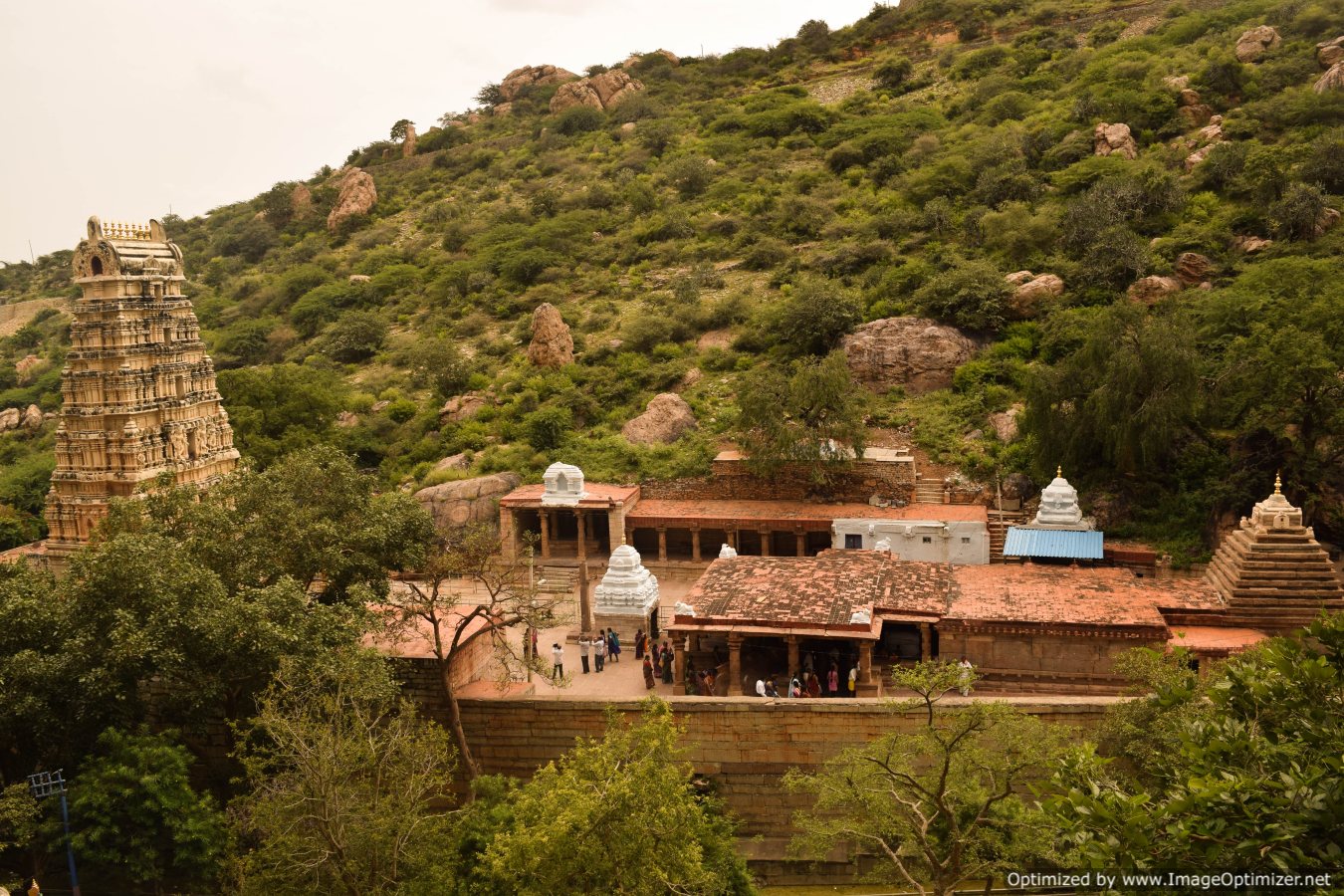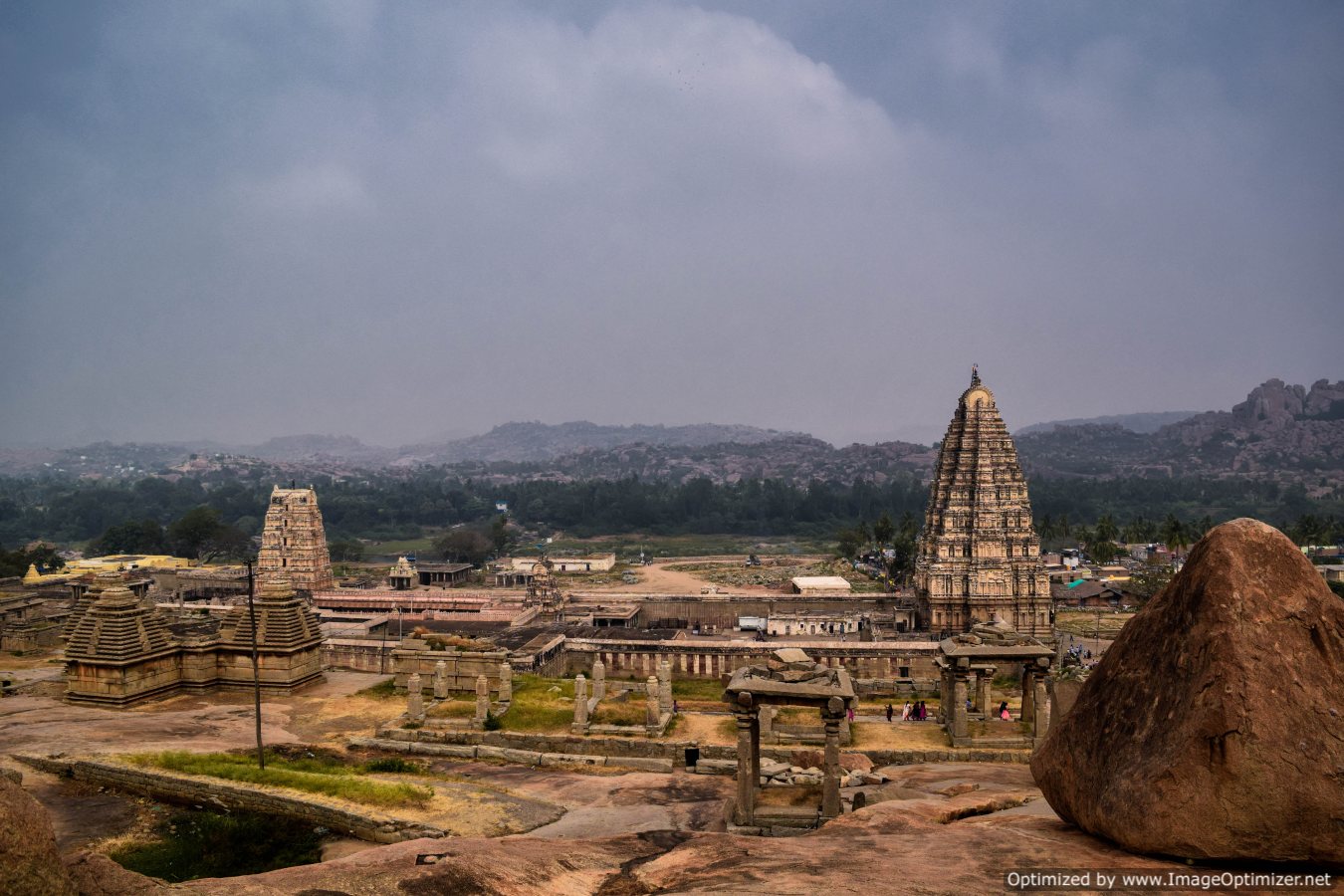It was more like an urge – to take the open road, the uncharted ways, make no itinerary, halt at the first stop, and explore, either ride into the sunset or melt with it. These were my first thoughts when I started my course of journey in the Eastern Ghats – starting with Kurnool, often referred to as the Gateway to Rayalseema – a province with a rich and varied history, a place of hot passions, of violent factionist loyalties, a land that was once the stronghold of Krishna Deva Raya, and was once a cultural pot of the Vijayanagar empire.

The imposing Buddha statue at Belum caves
I started my day with the defining feature of Kurnool – the Belum caves. I have to say, I liked the place almost instantly. My brain kept registering the unusual charms of the place, the hillocks (which I mistakenly took for caves) that surround the caves, impossibly calm and serene surroundings, the desolate roads, fragmented habitation, an unusual chill in the morning breeze, and an imposing Buddha Statue before the caves.
The caves were explored some 130 years back and came to AP Tourism’s notice in 1980s. This is an underground cave, some 3.5 km long with an underground river. The caves are well maintained and illuminated, timings are maintained, and guide service is mandatory. The entrance is a circular pit and right away one descends into it and moves into a spacious chamber with a circular opening overhead. I craned my neck to see a deep blue sky at the rim of the crater! That was my last glimpse of the sky for a while.

Belum caves
And in case if you are still wondering about what’s down there in the cave, there is history, some mythology and of course nature’s old and long processes which have given birth to typical cave formations stalactites and stalagmites (hope it reminds some of physical geography classes in schools).
Stalactites and stalagmites are limestone formations – stalactites are ‘roof hanging’ downward growing formations and stalagmites grow from the base towards the roof. In school I remembered them as ‘stalactite hold tight to the roof and stalagmite might reach the roof’. And then there is mythology around in the caves. There is a Shivlinga and a freshwater spring called ‘Patalganga’ deep inside where you need to go climbing the iron stairs and then to a narrow gauge. There are some meditations halls used by Buddhist monks going through the subterranean water channels.
The walk is arduous and the heat literally takes every ounce of water from the body but the natural formations, the intricately cut limestone walls as water took its turns, the play of lights as they fell on different surfaces, the hanging formations, and then the entire feeling of stepping into such unknown world; lights up the soul and instantly makes the onlookers feel a connection between themselves and the other world.

Patalganga in Belum caves
One look back at the Belum caves, a shot of the imposing Buddha statue, and then back on the road to Gandikota. We passed through desolate road, where tractors splashed sand on one side and velvet green paddy fields spread on the other, before everything changed to an untouched, unmeddled with landscape – flat, arid and sad.

Enroute to Gandikota
Gandikota (gandi means gorge and kota is the word for fort) is ruins of a fort built around 11th century, by a Chalukya king. The historical records say it was impassable, and well protected by the surrounding hills and deep valley, and certainly the gorges in the Pennar River. There is a centuries old temple there, built in Vijayanagar style with intricate work on the pillars. But it wasn’t the temple or the ruins I was interested in. I had come all this way on opposite end of the Belum caves, a distance of 40 Kms which took more than two hours, driving on flat, muddy lands with nothing on each side of the road except for some thorny shrubs for miles and some scattered water pools, for something much more than a centuries old temple.
We walked around through the ruins of a small fort, ignoring the pigeon towers, capturing the view of the barren dry red land, to find the canyon. Further up the temple, something seemed hidden behind the huge cliffs. In a hope of finding the Great Canyon of India, I ignored the temple, walked further, only to be left amazed. It was that couple of hundreds tall tower, standing on the banks of the river that hid the view I had come for. It was difficult to climb through the rocks to reach the right edge of the rocks to get a good grand look of something I had travelled so far for. It was helluva scary, but down was a view worth all pains. I gleefully smiled at the Columbus in me; before me were the Grand canyons of India. Deep gorges spread for miles, with the Pennar River snaking through it; just like the Colorado River. This was a canyon on Indian soil, not be as big as the Grand Canyons, but still majestic. And the view of the gorges, beyond words or pictures, was splendid. It is an experience, moments to live and itch in the memory lanes. The act of walking that eerie path, climbing the rocks, for a perfect view, braving the strong chilly wind smacking your face, and then the feeling of nothingless, being left in the neverland with nobody watching you; is probably too strong a feeling to be put in words. And after all the pains taken you find yourself in the land nature seemed to have meticulously created. Ah! even a poet would fail to describe the emotions. (I couldn’t take pics as my camera battery died then)
That one hour spent in the desolateness of Gandikota, the light air, the light feeling, I almost felt like growing wings and take a flight over this intricately fashioned geographical feature. Wish I could do that, flying over the greens, riding into the sunset, drink the melting shades in the sky or colour myself in those colours to become an inseparable part of it: might be a shade between the sinking blue and orange of the sky and the drunken green of the water below.

Yaganti Uma Maheshwara temple_Kurnool
We left Gandikota for another drive to Yaganti Uma Maheshwara temple, our last stop. The temple has some history and dusts off some science too. This temple was constructed by King Harihara Bukka Rayalu of the Sangama Dynasty of the Vijayanagara Empire in the 15th century. It was built according to vaishnaviate traditions. It is said that sage Agastya wanted to develop a temple of Lord Venketeshwara on this site, but the statue couldn’t be stalled. Hence he performed a penance for Lord Shiva and urged him to settle here with Goddess Parvati in a single stone, which the lord obliged. Now the science part – it is believed that the Nandi idol (bullock of Lord Shiva) outside the main temple, is continuously growing. Scientific estimates by Archaeological Survey of India put it at a growth rate of 1 inch every 20 years. The temple staff had to remove one of the pillars as the nandi size increased. While it might be the matter in the ambit of science, and could have something to do with the material composition of the idol, but it does invite much religious interest.


Yaganti temple from top
The temple surrounded with towering hillocks, set amidst deep forests, and with deep caves on the hillocks, inspires emotions and stories. Though only around 15 kms from the town of Banaganapalle the drive is through desolate lands wearing a rustic hue.
On your way to Yaganti, do halt at a summer palace of the rulers of Kurnool. Though it maybe crumbling from inside, the exteriors of this imposing structure, constructed with the locally-available stone, has withstood the ravages of time and is still in impressive shape.
If a cubicle dweller person in you seeks some silence and a thought of unwinding from the digitally driven today’s world, Kurnool is one place – away from all chaos. There is a certain connection you can feel as you leave the city and take these detours to places less known.

The ever growing Nandi

Fast facts: Kurnool is about 200 kms from Hyderabad and has good connectivity with Hyderabad. It is connected to all major cities via rail network. The APTDC hotel chain Haritha hotels is a good place to stay, apart from Kurnool, they have a dormitory in Belum caves and a hotel in Gandikota too to stay.

Opening at Belum caves_Kurnool









I feel like doing this place after reading this 😍
Thanks, you should, it’s an amazing place and very well connected to all major cities
Wotta beautiful post. I learnt abt a new interesting plc…
Thanks, even I wasn’t sure it is such a beautiful place, so much off-beat
Lovely write up. Enjoyed reading this one.
I have read about Gandikota earlier too. I’m not sure if this is similar to the canyons near Kota, Rajasthan on river Chambal since I haven’t seen both. You must check out this place called Garadia Mahadev. It’s been extensively advertised in Rajasthan Tourism adverts. I have also written about it in my blog.
I’ve read about Garadia Mahadev, haven’t been there yet. And rightly said Chambal also has great canyons, infact a trip across Bundelkhand on the so called badlands is super exciting and good to revive some old geography lessons. Shame that the Govt hasn’t been able to develop these for tourism.
Aakash, sometimes I feel it’s good that government has not developed a place for tourism. If you look around the tourist places, I feel they have actually deteriorated. Partly, people don’t have any sense -civic and moral! I may sound negative but that’s a sad truth. Opening any place for tourism means mass movement – traffic, pollution, filth in terms of plastics flying around,unauthorized construction & vendors, concrete structures….it’s a long list!
we should be happy that at least by not developing a place, it’s retains it’s charm. Some people tell me that it’s being selfish. May be, but I’m sure it’s good that way rather than killing it…completely! I see that happening around.
Well agree and definitely not every place should be mapped and developed or nomads like us will have very little exploration to do and yes getting artificial is no tourism
I guess we are in agreement here, Aakash! 🙂
If you would like to check out the post and pictures on Garadia Mahadev, here’s the link – https://jaipurthrumylens.com/2016/10/17/driving-to-garadia-mahadev-photo-story/
Sure, thanks
stunning your all pictures and article really nice.. thanks for sharing… keep it up… thanks a lot….!!
Thanks Lavit…great to know you liked it. Kurnool isn’t a very famous destination